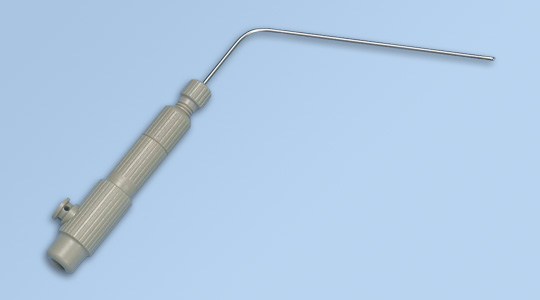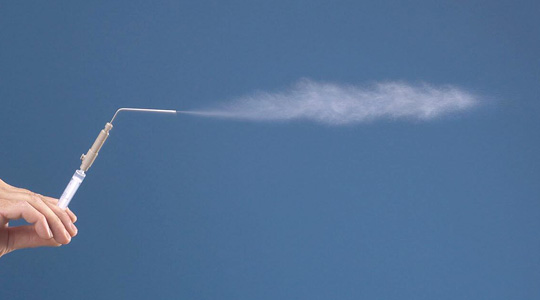
Model Number:
DP-4-GP
The Dry Powder Insufflator™ – Model DP-4-GP is designed for rapid, targeted, intratracheal powder administration to guinea pig. For pulmonary use, the very tip of the delivery tube must be positioned near but not touching the carina (first bifurcation) in an anesthetized animal. The device exerts a slight insufflating effect, permitting a precisely quantifiable dose of particles to penetrate deep into the lung. It may also be used for intranasal or in vitro applications. The device twists open at the center to reveal a sample chamber that can be filled manually with a small single dose (1 – 5 mg) of powdered material, protected from ambient air and moisture. The Model DP-4-GP operates with a 3 ml disposable air syringe (provided) or, for more rapid administration of air with less force and hand motion, a Penn-Century Air Pump. Dry methods of cleaning the device are preferred.
- Light, easy-to-use, hand-operated pulmonary drug delivery device
- Produces a precisely measurable cloud of fine particles from the end of a hollow, stainless steel delivery tube
- Can be used with powders of a wide range of sizes and characteristics from nanoparticles to large porous particles
- Powders are unaffected by passage through the device
- Widely tested with a range of pharmaceutical and bioactive compounds, as well as radiographic formulations.
- Also useful for testing and development of dry powder formulations – time-of-flight, PK/PD, etc.
- Widely used for occupational, environmental, bioterror and biohazard toxicology studies
- Must be weighed before and after loading and after discharging for precise quantification of delivered dose
- Sample chamber holds powder securely to prevent sample loss, moisture or contamination
- Reusable and sterilizable. Made of virtually indestructible, heat and chemically resistant PEEK™ (polyetheretherketone) plastic.
- Description: For fast, precise, targeted administration of a “cloud” of dry powder. Body of device made of chemically resistant PEEK™ plastic (polyetheretherketone) and silicone valves.
- Delivery tube: Made of rigid, hollow stainless steel 18-gauge tubing with rounded tip and 120-degree bend.
- Length of intratracheal portion: 3″ (7.6 cm) after 120-degree bend
- Outer diameter: .050″ (1.1 mm) except at rounded tip which is .058″
- Inner diameter: .038″ (0.9652 mm) hollow throughout
- Single dose range: 1-5 mg (Must be loaded with ONLY ONE dose at a time)
- For larger single doses: 100 mg Sample Chamber Extension may be attached for larger single doses.
- Operates with: Commercial 3ml plastic air syringe (provided). Can also be operated with a Penn-Century Air Pump for more rapid administration of air pulses of 0-5 ml. (100% dose delivery may require more than one pulse of air.)
- Particle size range: Dry Powder Insufflator™ can be loaded with dry powders in a very wide range of sizes from nanoparticles to large macroparticles. Device does not filter or affect powders traveling through it.
- Weight: 3.5 g empty weight, with standard (guinea pig) delivery tube
- Precision balance scale required: For precise quantification of the delivered dose, users will require a precision balance
- Reusable/Sterilizable: Stainless steel tip detachable, cleanable with liquid methods, and autoclavable. NOTE: Dry methods of cleaning are preferred for main PEEK™ portions of device
The Penn-Century Dry Powder Insufflator™ has been successfully used to aerosolize powders of a wide range of sizes and characteristics from nanoparticles to large porous particles. The device does not filter or affect the powder sample in any way. If the powder formulation is particularly likely to absorb ambient moisture, the device may be loaded in an air-tight glove bag. Once it is in the sample chamber, it is sealed off from ambient room air and humidity.
The following devices are helpful when working with the Dry Powder Insufflator™ – Model DP-4-GP in Guinea Pig:
- Small Animal Laryngoscope – Model LS-2-GP for Guinea Pig
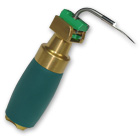
Model Number: LS-2-GP Description Specifications Diagram User Info Penn-Century’s Small Animal Laryngoscope Model LS-2-GP is specifically designed for use in guinea pig. It provides bright, clear illumination for better visualization of the trachea and epiglottis. It makes intratracheal intubation and insertion of Penn-Century’s MicroSprayer® Aerosolizers and Dry Powder Insufflators™ easier, quicker and safer. Each laryngoscope… Continue reading
$1,360.00
- Small Animal Laryngoscope – Model LS-2-GP for Guinea Pig
- Extra delivery tube for Guinea Pig – Model DP-EXT-GP
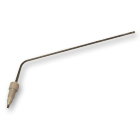
Model Number: DP-EXT-GP Description Specifications Diagram User Info The Extra Delivery Tube (DP-EXT-GP) is intended for those who currently own a Dry Powder Insufflator™ – Model DP-4-GP. The Dry Powder Insufflator™ – Model DP-4-GP is designed for rapid, targeted, intratracheal powder administration to guinea pig. The stainless steel delivery tube of the device is attached… Continue reading
$280.00
- Extra delivery tube for Guinea Pig – Model DP-EXT-GP
- Sample Chamber Extension – Model SC-X
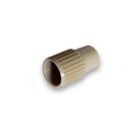
Model Number: SC-X Description Specifications Diagram User Info The Dry Powder Insufflator™ – Model DP-4 has a standard dose volume capacity of 1-5 mg. The 100 mg Sample Chamber Extension (SC-X) is designed to provide additional capacity for larger dose volumes when used with the Dry Powder Insufflator™ – Model DP-4. It is a hollow… Continue reading
$98.00
- Sample Chamber Extension – Model SC-X
 Penn-Century Dry Powder Insufflator™ – Model DP-4 consists of an Air Intake and Sample Chamber to which a hollow delivery tube is connected. The device twists open at the center to permit the Sample Chamber to be filled manually with a small single dose (1 – 5 mg) of powdered material, using a narrow spatula. The two halves are then gently but firmly press-fit back together, protecting the powder sample from ambient air and moisture. The tip of the air source, either the 3 ml air syringe or the Penn-Century Air Pump, is then inserted into the opening at the back of the Air Handler. The delivery tube is made of stainless steel and is attached to the device by a PEEK™ fitting. The tube and fitting can be unscrewed from the Sample Chamber and cleaned separately using wet methods if desired. It must be thoroughly dried before reattaching to the device. NOTE: Powder should neverbe loaded into the Air Handler as this may prevent the device from functioning properly.
Penn-Century Dry Powder Insufflator™ – Model DP-4 consists of an Air Intake and Sample Chamber to which a hollow delivery tube is connected. The device twists open at the center to permit the Sample Chamber to be filled manually with a small single dose (1 – 5 mg) of powdered material, using a narrow spatula. The two halves are then gently but firmly press-fit back together, protecting the powder sample from ambient air and moisture. The tip of the air source, either the 3 ml air syringe or the Penn-Century Air Pump, is then inserted into the opening at the back of the Air Handler. The delivery tube is made of stainless steel and is attached to the device by a PEEK™ fitting. The tube and fitting can be unscrewed from the Sample Chamber and cleaned separately using wet methods if desired. It must be thoroughly dried before reattaching to the device. NOTE: Powder should neverbe loaded into the Air Handler as this may prevent the device from functioning properly.
Delivery tube of Dry Powder Insufflator™ – Model DP-4-GP for Guinea Pig
Dimensions (approx.)
| A | B | C |
|---|---|---|
| 3″ | 120° | 5/8″ |
Key:
Length “A”: Functional length, from bend to tip
Angle “B”: Angle of bend
Length “C”: Length from hub to bend
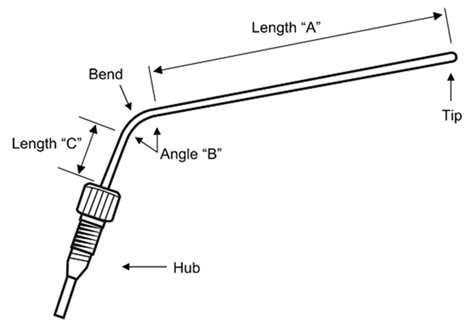
For intratracheal applications with the Dry Powder Insufflator™, optimal concentration and uniform deposition in the lung is achieved when the tip of the device is close to but not touching the carina. The intratracheal portion of the Model DP-4-GP is designed to be inserted directly into the trachea and reach from the front incisors to the carina in a standard size guinea pig.
Users may also pre-intubate the animal and insert the device down the trachea to the carina via an endotracheal tube. Doing so requires that the user calculate the measurements carefully:
- If tip of the Dry Powder Insufflator™ is inserted into an endotracheal tube, the distal tip must emerge slightly from the end of the endotracheal tube when it is in position
- To avoid injury, neither the distal tip of endotracheal tube nor the distal tip of the Dry Powder Insufflator™ should make contact with the carina when the plunger of the air syringe is pushed
Intratracheal use of Penn-Century devices
For best results, position the tip
of the device near to – but not
touching the carina, or first
bifurcation.
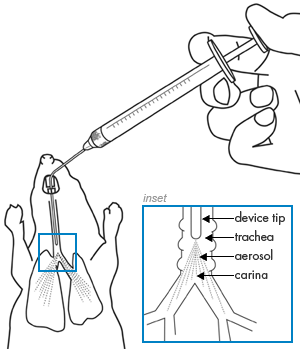
The process of intratracheal administration is essentially a form of intubation. For intrapulmonary applications, the tip of the device is gently inserted down the trachea of the anesthetized animal – near to, but not touching the carina (first bifurcation).
For complete details, please refer to the Instructions for Use for the Penn-Century Dry Powder Insufflator™ – Model DP-4
Overview
- A precision balance is required to quantify the dose.
Use of the Dry Powder Insufflator™ – Model DP-4 requires a precision scale or balance. The device must be precisely weighed before and after filling and after each application of air to quantify the delivered dose and to determine how many applications of air will be required to dispense 100% of that dose. - Insufflation of the powder sample.
The Model DP-4 is operated with either a 3 ml commercial air syringe (provided) or a Penn-Century Air Pump (sold separately). The air source is firmly press-fit into the proximal end of the Air Handler to insufflate the powder sample with puffs or pulses of air. NOTE: To avoid injury and hyperinflation to the experimental animal, the volume of air in the air source must be set to the correct volume for the lung capacity of the experimental animal. For rat, air volumes must not exceed 2 ml. For guinea pig, air volumes must not exceed 3 ml. Some powder formulations may require more than one application of air to dispense 100% of the powder. - Positioning of the delivery tube in the trachea.
For optimal deposition and distribution in the lung, the very tip of the Dry Powder Insufflator™ must be carefully positioned in the trachea of the anesthetized animal so that the tip of the delivery tube is above the carina, as indicated in the drawing (right). To insufflate the powder with an air syringe requires the user to push the plunger rapidly and with force. At the same time, great care must be taken, when pushing the plunger of the air syringe, to avoid excessive hand motion that may result in pushing the tip of the device forward and causing injury to the animal. If the user is using a spring-loaded Penn-Century Air Pump instead of the air syringe, less force and hand motion is required to produce a puff of air of a specific volume. For detailed technical information, refer to the Instructions for Use. - Cleaning of the main device body – Dry methods preferred.
In general, the Dry Powder Insufflator™ is constructed of sterilizable materials. Due to the complex nature of the valve system inside, dry methods of cleaning are preferred. Liquid methods of cleaning the device, such as alcohol, organic solvents (ethanol or methanol), or water are less desirable than physical methods. Liquids, especially water, may work themselves into small crevices where they may interfere with subsequent powder deliveries. (Please note that dessication systems are designed to remove water – not solvents.) To clean the Sample Chamber, detach it from the Air Intake and direct a small stream of air or other compressed gas. (“Dust-Off” or a similar product for cleaning computer keyboards will do.) Take care not to thrust the nozzle of the air source into the Sample Chamber to avoid damage to the valve assembly. Do not use excessively forceful compressed air sources. If you have particular questions or concerns about acceptable methods of cleaning, feel free to contact us with your questions. - Cleaning the stainless steel delivery tube.
The delivery tube of the device is hollow and detachable, and may be cleaned separately. The device may be autoclaved or immersed in water, organic solvent or disinfectant. It should be thoroughly and completely dried – using compressed air or by air drying it – prior to reattaching to the body of the device. To remove the delivery tube, simply twist the 10-32 fitting 1/4-turn counterclockwise and pull the tube out. To replace, push the stainless steel tube in to a hard stop and twist the fitting 1/4-turn clockwise, or until some resistance is felt. Do not overtighten.

